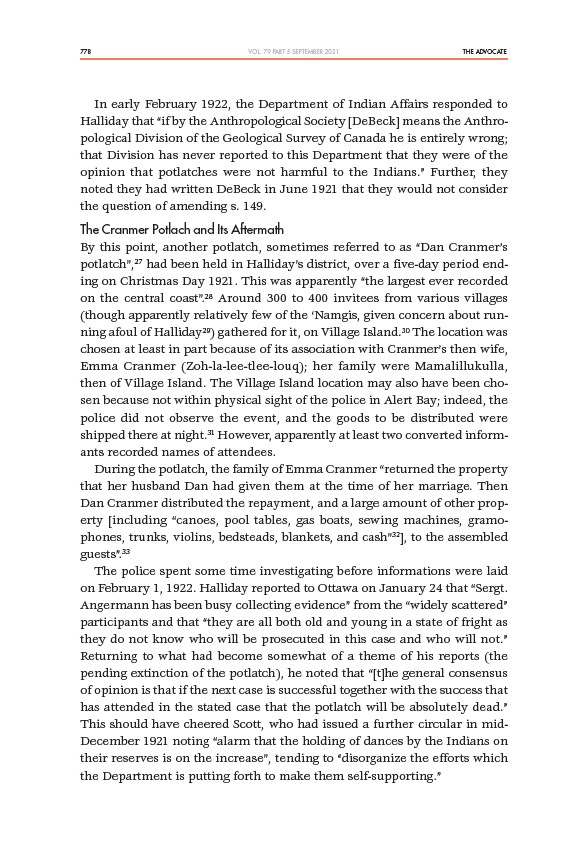
778 THE ADVOCATE
VOL. 79 PART 5 SEPTEMBER 2021
In early February 1922, the Department of Indian Affairs responded to
Halliday that “if by the Anthropological Society DeBeck means the Anthropological
Division of the Geological Survey of Canada he is entirely wrong;
that Division has never reported to this Department that they were of the
opinion that potlatches were not harmful to the Indians.” Further, they
noted they had written DeBeck in June 1921 that they would not consider
the question of amending s. 149.
The Cranmer Potlach and Its Aftermath
By this point, another potlatch, sometimes referred to as “Dan Cranmer’s
potlatch”,27 had been held in Halliday’s district, over a five-day period ending
on Christmas Day 1921. This was apparently “the largest ever recorded
on the central coast”.28 Around 300 to 400 invitees from various villages
(though apparently relatively few of the ‘Namgis, given concern about running
afoul of Halliday29) gathered for it, on Village Island.30 The location was
chosen at least in part because of its association with Cranmer’s then wife,
Emma Cranmer (Zoh-la-lee-tlee-louq); her family were Mamalillukulla,
then of Village Island. The Village Island location may also have been chosen
because not within physical sight of the police in Alert Bay; indeed, the
police did not observe the event, and the goods to be distributed were
shipped there at night.31 However, apparently at least two converted informants
recorded names of attendees.
During the potlatch, the family of Emma Cranmer “returned the property
that her husband Dan had given them at the time of her marriage. Then
Dan Cranmer distributed the repayment, and a large amount of other property
including “canoes, pool tables, gas boats, sewing machines, gramophones,
trunks, violins, bedsteads, blankets, and cash”32, to the assembled
guests”.33
The police spent some time investigating before informations were laid
on February 1, 1922. Halliday reported to Ottawa on January 24 that “Sergt.
Angermann has been busy collecting evidence” from the “widely scattered”
participants and that “they are all both old and young in a state of fright as
they do not know who will be prosecuted in this case and who will not.”
Returning to what had become somewhat of a theme of his reports (the
pending extinction of the potlatch), he noted that “the general consensus
of opinion is that if the next case is successful together with the success that
has attended in the stated case that the potlatch will be absolutely dead.”
This should have cheered Scott, who had issued a further circular in mid-
December 1921 noting “alarm that the holding of dances by the Indians on
their reserves is on the increase”, tending to “disorganize the efforts which
the Department is putting forth to make them self-supporting.”